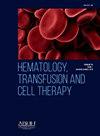乳朊蛋白-111衍生的锝- 99m放射性标记肽在乳腺癌模型中的生物分布
IF 1.6
Q3 HEMATOLOGY
引用次数: 0
摘要
乳腺癌是一个重大的公共卫生问题,是妇女中第二常见的肿瘤类型。根据世界卫生组织(世卫组织)的数据,每年有1400多万人患乳腺癌,预计到2030年这一数字将增加到2100多万。研究表明,从laminin-111衍生的生物活性肽可以调节乳腺癌源性细胞的基因表达,其中YIGSR肽尤其令人感兴趣。设计用于抑制细胞内信号通路的肽属于分子靶向治疗领域,通常关注肿瘤中过度表达的受体。HYIGSR肽是一种层联蛋白-111衍生物,用锝-99m ([99mTc]Tc(CO)3)放射性标记,在对照和乳腺癌模型小鼠的生物分布试验中评估其生物学行为。材料与方法采用三羰基法对HYIGSR肽进行放射性标记,用有机金属水离子[99mTc(H2O)3(CO)3]+(简称[99mTc]Tc(CO)3)标记组氨酸残基。在70°C条件下,在1 atm CO下还原[99mTc]TcO4- 30分钟,然后在85°C条件下,用约148 MBq的[99mTc]Tc(CO)3孵育30分钟。以0.9% NaCl为洗脱液,用TLC-SG条测定[99mTc]Tc(CO)3-HYIGSR的放射化学纯度。用1 × 10⁷MDA-MB-231乳腺癌细胞接种雌性Balb/c裸鼠,建立乳腺癌动物模型。30天后,进行体内(分子成像)和离体生物分布研究。将放射性标记肽静脉注射给健康和荷瘤雌性Balb/c裸鼠,并在注射后1和3小时进行体外生物分布分析。健康小鼠分子成像采用Discovery VH临床伽玛相机单孔准直器平面闪烁成像,获取时间为5 min,几何放大倍数为9 × 。所有动物实验均遵守当地动物研究伦理准则(协议号:CEUA - HIAE 6015-24)。结果[99mTc]Tc(CO)3放射标记工艺标准化,得到的[99mTc]Tc(CO)3- hyigsr放射化学纯度为95.53±1.19% (n = 5)。雌性Balb/c裸鼠(n = 4)的体外生物分布分析显示,随着时间的推移,血液清除迅速,肾脏摄取增加。在心脏、脾脏、肺和肌肉中观察到放射性标记肽的最小积累,每克注射剂量的百分比(%ID/g)保持在5%以下。然而,在肝脏、胃、肠和甲状腺中观察到高摄取。荷瘤小鼠的肿瘤摄取率为0.58±0.25% ID/g,瘤肌比为1.54±0.14。健康组的初步分子成像证实了体内生物分布结果与离体数据一致。结论这些发现表明,虽然[99mTc]Tc(CO)3-HYIGSR复合物显示出有效的放射性标记,但可能需要进一步修饰以增强其肿瘤靶向能力并提高其整体诊断潜力。本文章由计算机程序翻译,如有差异,请以英文原文为准。
BIODISTRIBUTION OF A TECHNETIUM-99M RADIOLABELED PEPTIDE DERIVED FROM LAMININ-111 IN A BREAST CANCER MODEL
Introduction/Justification
Breast cancer is a significant public health concern, ranking as the second most common tumor type among women. According to the World Health Organization (WHO), more than 14 million people develop breast cancer annually, with this number projected to rise to over 21 million by 2030. Studies have shown that biologically active peptides derived from laminin-111 can regulate gene expression in breast cancer-derived cells, among which the YIGSR peptide is of particular interest. Peptides designed to inhibit intracellular signaling pathways fall within the realm of molecular targeted therapies, which commonly focus on receptors overexpressed in tumors.
Objectives
This study aimed to evaluate the biological behavior of the HYIGSR peptide, a laminin-111 derivative, radiolabeled with technetium-99m ([99mTc]Tc(CO)3), in a biodistribution assay using both control and breast cancer model mice.
Materials and Methods
The HYIGSR peptide was radiolabeled using the tricarbonyl method, which enabled labeling at the histidine residue with the organometallic aqua-ion [99mTc(H2O)3(CO)3]+, abbreviated as [99mTc]Tc(CO)3. The reaction was carried out by reducing [99mTc]TcO4- under 1 atm of CO for 30 min at 70°C, followed by incubation with approximately 148 MBq of [99mTc]Tc(CO)3 for 30 min at 85°C. The radiochemical purity of [99mTc]Tc(CO)3-HYIGSR was assessed using TLC-SG strips with 0.9% NaCl as the eluent. A breast cancer animal model was established by inoculating female Balb/c nude mice with 1 × 10⁷ MDA-MB-231 breast cancer cells. After 30 days, in vivo (molecular imaging) and ex vivo biodistribution studies were performed. The radiolabeled peptide was intravenously administered to both healthy and tumor-bearing female Balb/c nude mice, and ex vivo biodistribution analysis was conducted at 1 and 3 h post-injection. Molecular imaging of healthy mice was acquired via planar scintigraphy using a single-hole collimator on a Discovery VH clinical gamma camera, with an acquisition time of 5 min and a geometric magnification of 9 × . All animal experiments adhered to local ethical guidelines for animal research (Protocol number: CEUA – HIAE 6015-24).
Results
The radiolabeling process using [99mTc]Tc(CO)3 was successfully standardized, yielding [99mTc]Tc(CO)3-HYIGSR with a radiochemical purity of 95.53 ± 1.19% (n = 5). Ex vivo biodistribution analysis in female Balb/c nude mice (n = 4) demonstrated rapid blood clearance over time, with increased uptake in the kidneys. Minimal accumulation of the radiolabeled peptide was observed in the heart, spleen, lungs, and muscle, with the percentage of the injected dose per gram (%ID/g) remaining below 5%. However, high uptake was observed in the liver, stomach, intestine, and thyroid. In tumor-bearing mice, tumor uptake was measured at 0.58 ± 0.25 %ID/g, with a tumor-to-muscle ratio of 1.54 ± 0.14. Preliminary molecular imaging in the healthy group confirmed in vivo biodistribution findings consistent with ex vivo data.
Conclusion
These findings suggest that while the [99mTc]Tc(CO)3-HYIGSR complex demonstrated efficient radiolabeling, further modifications may be necessary to enhance its tumor-targeting capabilities and improve its overall diagnostic potential.
求助全文
通过发布文献求助,成功后即可免费获取论文全文。
去求助
来源期刊

Hematology, Transfusion and Cell Therapy
Multiple-
CiteScore
2.40
自引率
4.80%
发文量
1419
审稿时长
30 weeks
 求助内容:
求助内容: 应助结果提醒方式:
应助结果提醒方式:


